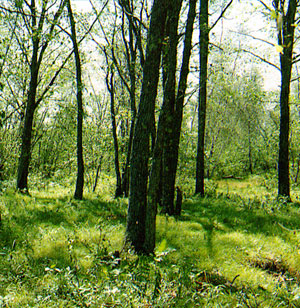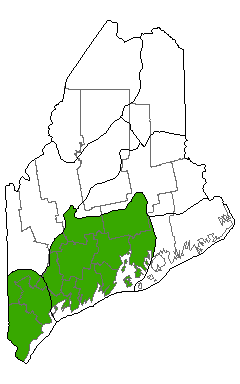DACF Home → Bureaus & Programs → Maine Natural Areas Program → Communities, Plants, and Animals → Natural Community Fact Sheets → White Oak - Red Oak Forest
Printer Friendly Fact Sheet - 1.4 MB pdf (Get a free copy of Adobe Acrobat Reader)
White Oak - Red Oak Forest
Scientific Name: White Oak - Red Oak Forest; State Rank: S3

- Community Description
- Soil and Site Characteristics
- Diagnostics
- Similar Types
- Conservation, Wildlife and Management Considerations
- Distribution
- Characteristic Plants
- Associated Rare Plants
- Associated Rare Animals
- Examples on Conservation Lands You Can Visit
Community Description: This deciduous forest type is dominated by red oak with white oak as a canopy associate. White pine is occasionally present, but conifers comprise only a small proportion (<20%) of the canopy. Sugar maple and beech may be present in minor amounts. Shrubs occur as well spaced patches; typical species include striped maple and ironwood. The forest floor is characterized by low heath shrubs such as lowbush blueberry. Common herbs include woodland sedge, bracken fern, whorled loosestrife, and Canada mayflower. Bryoids are very sparse. Back to top.
Soil and Site Characteristics: Sites of this type are on well drained gentle slopes (up to 20%) below 600 feet elevation. The soil is generally well drained, stony, sandy loam, fairly acidic (pH 4.8-5.0), and 20-50 cm deep. These forests are usually on somewhat sheltered sites. Back to top.
Diagnostics: Forests dominated by a mixture of red oak and white oak, without a strong white pine or hickory component. White oak forms at least 25% of the canopy. Back to top.
Similar Types: Oak - Pine Forests lack white oak and may have white pine co-dominant with red oak. Oak - Northern Hardwoods Forests lack white oak and have a larger component of beech or sugar maple. Shagbark hickory is dominant in Oak - Hickory forests. Back to top.
Conservation, Wildlife and Management Considerations: The few mature sites of White Oak - Red Oak Forest known to remain in Maine are all on land that was once cleared. The known sites are subject to fragmentation by timber harvesting, clearing for agriculture, and residential development, uses that have reduced this naturally rare type even further. Community dynamics are not well known, but there are some indications that red oak regenerates more strongly than white oak at some sites and may replace it over time. Fire may also play a role in natural regeneration. Most occurrences of this type are on private lands.
This type offers habitat for a variety of birds, including scarlet tanager and ovenbird. Mature occurrences of this community type offer excellent potential sites for cavity dwellers such as the southern flying squirrel. The rare red-winged sallow moth uses red oak as one of its host plants and may be found in this community. Back to top.
Distribution: Restricted primarily to southern Maine, characteristic of the Eastern Broadleaf Forest Province. Landscape Pattern: Small to Large Patch, generally 100 acres or less. Back to top.


Characteristic Plants: These plants are frequently found in this community type. Those with an asterisk are often diagnostic of this community.
- Canopy
- Red oak*
- Sugar maple
- White oak*
- Herb
- Rough-leaved ricegrass
- Wild sarsaparilla
- Wild-oats
- Wintergreen
- Woodland sedge*
- Early hairstreak
- Red-winged sallow
- Whip-poor-will
Examples on Conservation Lands You Can Visit
| Example | County |
|---|---|
| Mt Agamenticus | York Co. |
| Sebago Lake State Park | Cumberland Co. |